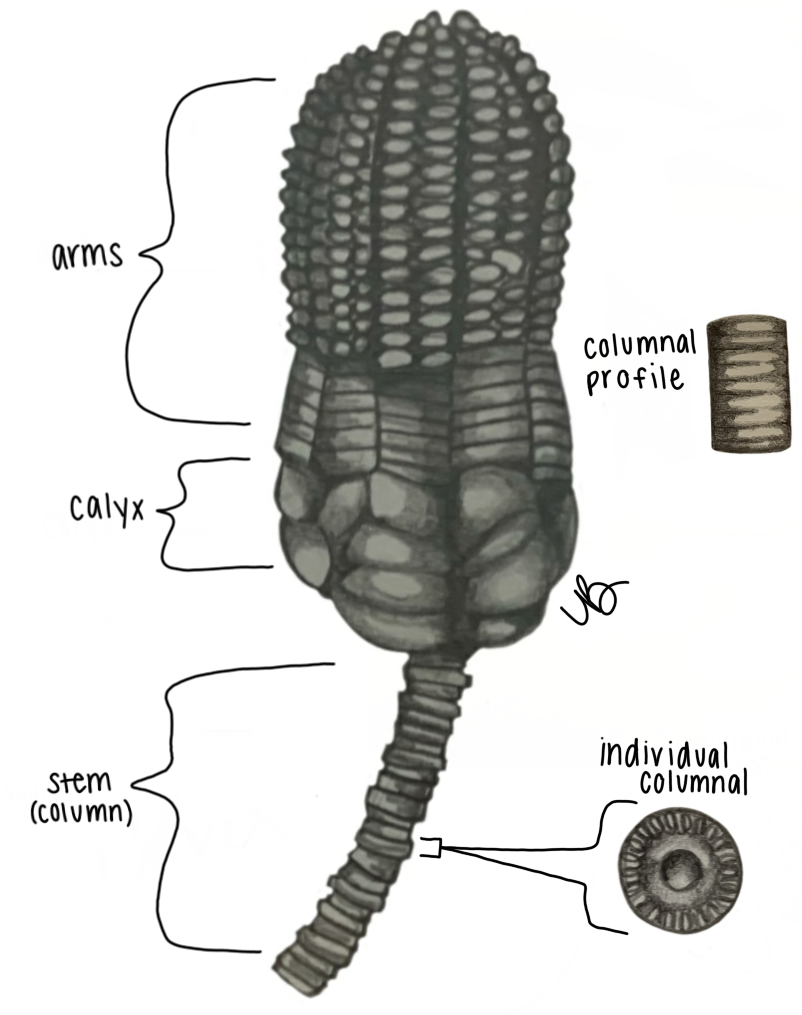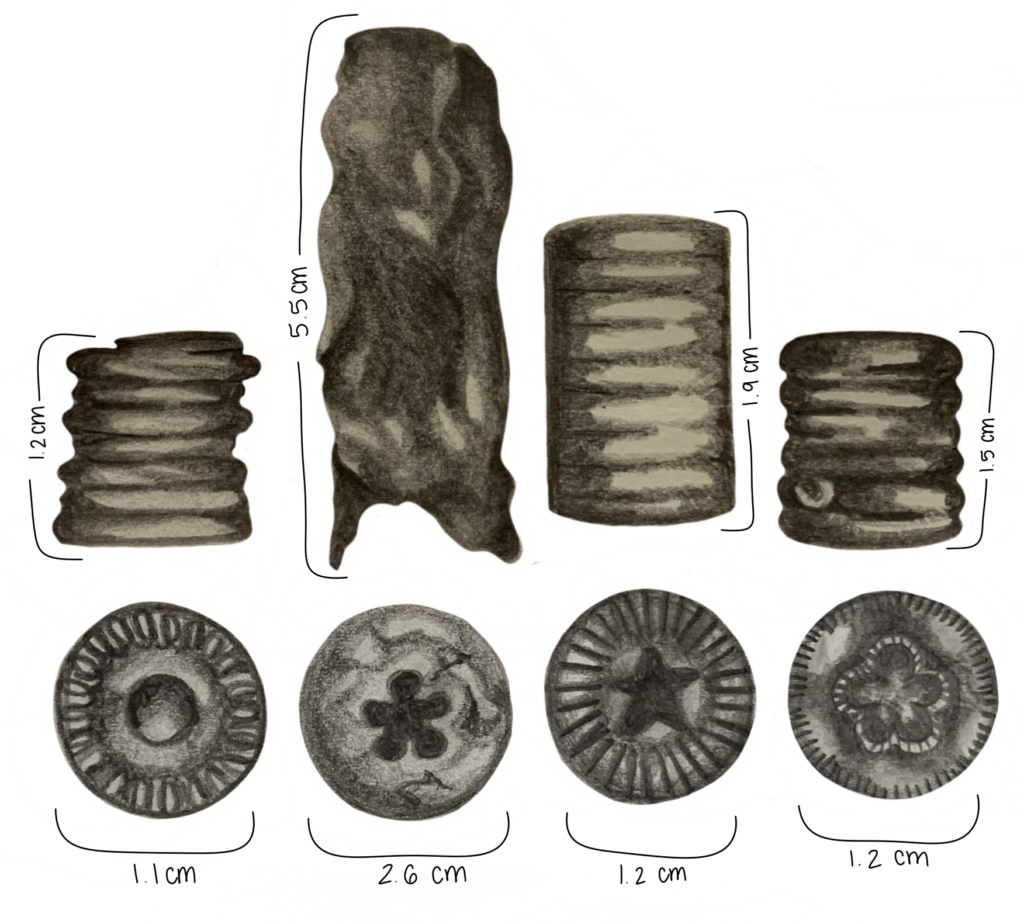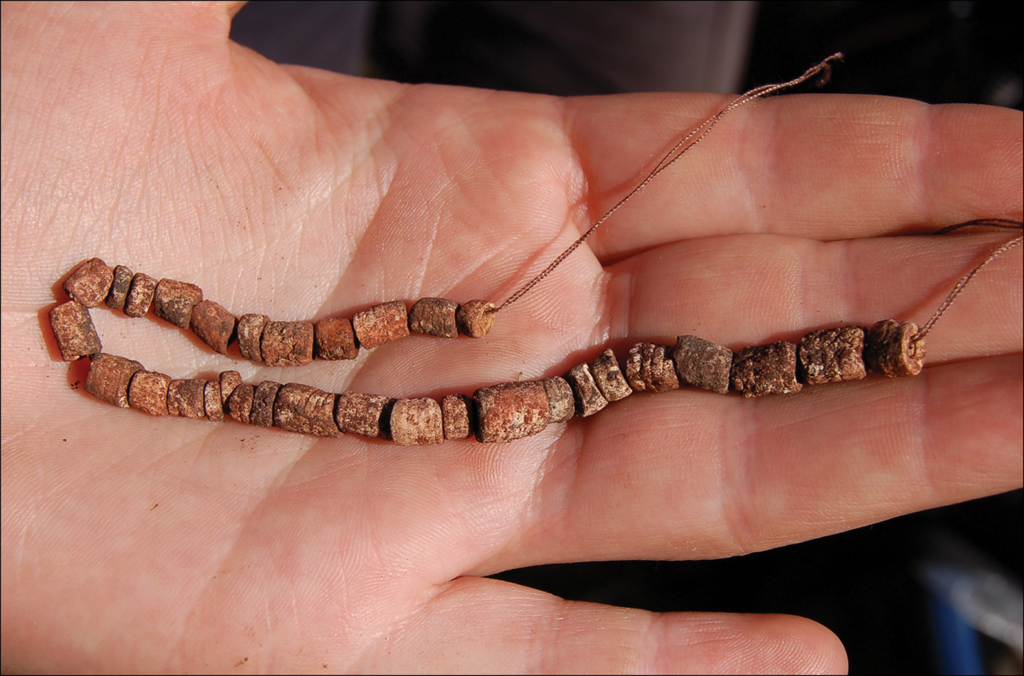by Elizabeth A. Begley and Albert D. Kollar
Did you know that invertebrate fossils make up more than 50% of the specimens on exhibit in Dinosaurs in Their Time (DITT)? It’s true! But these fossils can be easy to miss among the giant dinosaurs and vertebrate reptiles. Luckily, ongoing research on the biodiversity within our gallery spaces, from locations including England, Germany, and the United States, will help visitors better understand the importance of the Carnegie Museum of Natural History’s Invertebrate Paleontology collection research, exhibition, and education initiatives1. With few exceptions, these specimens are part of the vast Ernest de Bayet fossil collection purchased for the museum by Andrew Carnegie in 19031,2.
What are Crinoids?
Among these invertebrates are a unique group of sea bearing animals called crinoids. Crinoids are an ancient fossil group that belong to the phylum Echinodermata. Crinoids first appeared in the fossil record in the mid-Cambrian Period of the Paleozoic Era (490 – 250 million years ago) and became a significant group that formed mid-Silurian reefs in Dudley, Wales; Gotland Island, Sweden; and Milwaukee, Wisconsin. In the Mesozoic Era, crinoids formed the famous middle Triassic reefs of Germany3. Few crinoid groups live in oceans today. Examples of crinoids are on display in the museum’s Triassic Seas, Holzmaden, and Solnhofen dioramas (all locations in Germany)1. Crinoids are also called sea lilies because they look like flowers – but don’t be fooled, they’re animals! Crinoids are related to starfish, sea urchins, and brittle stars; this relationship can be noted in the crinoids five-part radial symmetry3,4. They lived on stems (or stalks) and attached to the sea floor by roots, as in the Triassic Muschelkalk Formation, but were floating animals in the Jurassic Holzmaden seas. They relied on waves and currents to bring small food particles past their petal-like arms which opened as a mode of filter-feeding micro-organic food3,4. Today, Crinoids are few in numbers living among shallow coral reefs and in the deep sea. The Bayet Collection of crinoid fossils are represented from the Silurian, Mississippian, and Triassic rock formations1.

However, crinoid fossils are more than scientific material reserved for use by paleontologists alone, in fact, this invertebrate animal is unique as it gives us the opportunity to see how humans have long interacted with nature. Specifically, fossilized crinoid stems have been used in several communities and throughout history as beads. This is due to their small size, cylindrical shape, and the usual occurrence of a hole in the center (fig. 2). So, let’s explore how crinoid fossils have been used on different continents and in different eras of human history.

Crinoid Beads in North America
In Kentucky, amateur fossil hunters commonly refer to crinoid stem fossils as beads5 and the Illinois Archaeological Survey has reported “crinoid stems suggested to function as beads” at a historic site in Buckman Flats6. This finding joins crinoid stems already uncovered in Kickapoo territories in 2011 and 1992 as well as a 2001 discovery at a Potawatomi settlement6. To illustrate an example of historic beadwork by North American indigenous groups, Harvard’s Peabody Museum of Archaeology and Ethnology has published a photograph depicting a “string of prehistoric beads made from different sizes of fossilized crinoid stem[s]” discovered in Tennessee7.
Crinoid Beads in Asia
From the lower paleolithic period in Israel, a deposit at the archaeological site of Gesher Benot Ya’aqov revealed two “beadlike” crinoid fossils among stone artwork and polished wood artifacts. This collection is thought to hint at the group’s cognitive ability regarding the manipulation of nature for artistic and cultural purposes and has brought the hypothesis that lower paleolithic hominids collecting crinoid stems, among other marine objects, may be the origin of the modern bead shape8. The thought process behind this theory relies on our understanding that crinoids, and their fossilized stems, have existed for far longer than the modern bead has. Bednarik argues, “perhaps this is how the very concept came into being, and the humanly made disc beads were merely substitutes for the fossils that were in short supply”9.
Crinoid Beads in Europe
While there are several instances of crinoid stems being recognized in historic European art and culture, the cemetery at Zvejnieki in Latvia is a unique case as the stems, or “beads,” seem to be a part of funerary practice. Zvejnieki was in use during the region’s Mesolithic and Neolithic periods and rediscovered by archaeologists in the 1960s. Work at the site has continued and a re-analysis of a double burial revealed that a beaded ornament among the remains, previously believed to have been made of bird bone, is a string of fossilized crinoid stems10. This case brings us to an interesting question in assessing the use of fossils, such as crinoid stems, throughout human history, and the impact of such encounters on our current relationship with the natural world.

So, the next time you walk through the museum, we invite you to take a closer look at the crinoids, and other invertebrate fossils on display, and imagine how else we may incorporate them in our lives!
Elizabeth A. Begley is Collection Assistant and Albert D. Kollar Collection Manger in the Section of Invertebrate Paleontology at Carnegie Museum of Natural History.
References:
- Kollar, A.D., J. L. Wilson, and S.K. Mills. 2024. The Ernest de Bayet Fossil Collection at the Carnegie Museum of Natural History: A Century of Stewardship in Exhibition. Annals of Carnegie Museum.
- Wilson, J. L., A.D. Kollar, and S.K. Mills. 2024. Unraveling the 120 Year Mystery of Ernest Bayet and his Fossil Collection at Carnegie Museum. Annals of Carnegie Museum.
- Hess, H., W. I. Ausich, C. E. Brett, and M.J. Simms. 1999. Fossil Crinoids. Cambridge University Press.
- Brezinski, D.K., and A.D. Kollar. 2008. Geology and Fossils of the Tri-State Region Learning/Activities/Coloring Book. PAlS Publication 8.
- Kentucky Geological Survey. Identifying Unknown Fossils. https://www.uky.edu/KGS/fossils/fossilid.php
- Fishel, R. 2017. The Historic Indian Artifact Assemblage at Buckman Flats, Knox County, Illinois. Illinois Archaeology Vol. 29.
- Peabody Museum of Archaeology and Ethnology. String of prehistoric beads made from different sizes of fossilized crinoid stem. Artstor. https://www-jstor-org.cmu.idm.oclc.org/stable/community.20420806
- Bednarik, R. 1994. The Pleistocene Art of Asia. Journal of World Prehistory, 8(4), 351–375. http://www.jstor.org/stable/25800655
- Bednarik, R. 2005 .Middle Pleistocene Beads and Symbolism. Anthropos, 100(2), 537-552. http://www.jstor.org/stable/40466555
- Macāne, A. 2020. Petrified animals: Fossil beads from a Neolithic hunter-gatherer double burial at Zvejnieki in Latvia. Antiquity, 94(376), 916-931. doi:10.15184/aqy.2020.124 https://www.cambridge.org/core/journals/antiquity/article/petrified-animals-fossil-beads-from-a-neolithic-huntergatherer-double-burial-at-zvejnieki-in-latvia/A325BCCE572DA6DD3AE913E7C22C18C2
Related Content
Meet the Mysterious Mr. Ernest Bayet
Bayet and Krantz: 16 Words (Part 1)
Carnegie Museum of Natural History Blog Citation Information
Blog author: Begley, Elizabeth A.; Kollar, Albert D.Publication date: March 1, 2024
